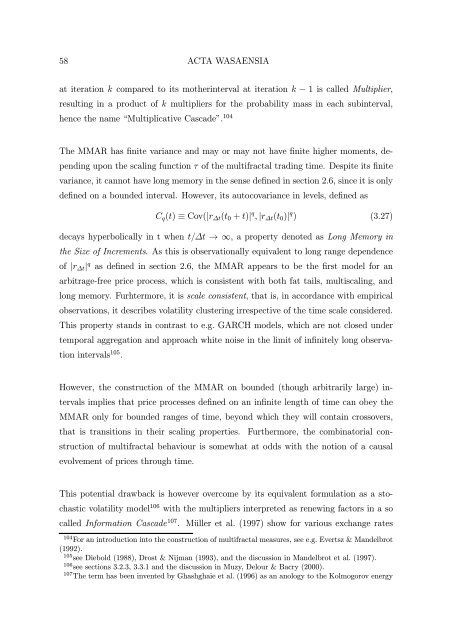BERND PAPE Asset Allocation, Multivariate Position Based Trading ...
BERND PAPE Asset Allocation, Multivariate Position Based Trading ...
BERND PAPE Asset Allocation, Multivariate Position Based Trading ...
Create successful ePaper yourself
Turn your PDF publications into a flip-book with our unique Google optimized e-Paper software.
58 ACTA WASAENSIAat iteration k compared to its motherinterval at iteration k − 1 is called Multiplier,resulting in a product of k multipliers for the probability mass in each subinterval,hence the name “Multiplicative Cascade”. 104The MMAR has finite variance and may or may not have finite higher moments, dependingupon the scaling function τ of the multifractal trading time. Despite its finitevariance, it cannot have long memory in the sense defined in section 2.6, since it is onlydefined on a bounded interval. However, its autocovariance in levels, defined asC q (t) ≡ Cov(|r ∆t (t 0 + t)| q , |r ∆t (t 0 )| q ) (3.27)decays hyperbolically in t when t/∆t →∞, a property denoted as Long Memory inthe Size of Increments. As this is observationally equivalent to long range dependenceof |r ∆t | q as defined in section 2.6, the MMAR appears to be the first model for anarbitrage-free price process, which is consistent with both fat tails, multiscaling, andlong memory. Furhtermore, it is scale consistent, that is, in accordance with empiricalobservations, it describes volatility clustering irrespective of the time scale considered.This property stands in contrast to e.g. GARCH models, which are not closed undertemporal aggregation and approach white noise in the limit of infinitely long observationintervals 105 .However, the construction of the MMAR on bounded (though arbitrarily large) intervalsimplies that price processes definedonaninfinite length of time can obey theMMAR only for bounded ranges of time, beyond which they will contain crossovers,that is transitions in their scaling properties. Furthermore, the combinatorial constructionof multifractal behaviour is somewhat at odds with the notion of a causalevolvement of prices through time.This potential drawback is however overcome by its equivalent formulation as a stochasticvolatility model 106 with the multipliers interpreted as renewing factors in a socalled Information Cascade 107 . Müller et al. (1997) show for various exchange rates104 For an introduction into the construction of multifractal measures, see e.g. Evertsz & Mandelbrot(1992).105 see Diebold (1988), Drost & Nijman (1993), and the discussion in Mandelbrot et al. (1997).106 see sections 3.2.3, 3.3.1 and the discussion in Muzy, Delour & Bacry (2000).107 The term has been invented by Ghashghaie et al. (1996) as an anology to the Kolmogorov energy
















